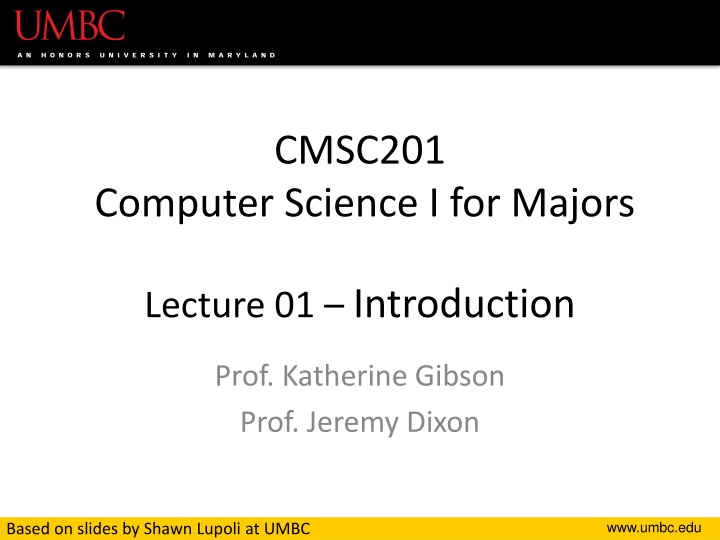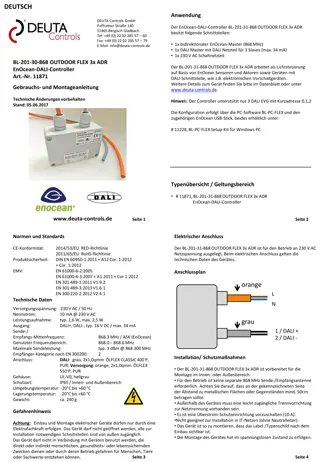
CMSC201 Computer Science I Course Overview and Objectives
Discover the essentials of CMSC201 Computer Science I for Majors with Prof. Katherine Gibson and Prof. Jeremy Dixon at UMBC. Gain insights into the course objectives, what it entails, and why learning to program is essential for various fields. Explore algorithmic problem-solving, Python programming, and more.
Download Presentation

Please find below an Image/Link to download the presentation.
The content on the website is provided AS IS for your information and personal use only. It may not be sold, licensed, or shared on other websites without obtaining consent from the author. If you encounter any issues during the download, it is possible that the publisher has removed the file from their server.
You are allowed to download the files provided on this website for personal or commercial use, subject to the condition that they are used lawfully. All files are the property of their respective owners.
The content on the website is provided AS IS for your information and personal use only. It may not be sold, licensed, or shared on other websites without obtaining consent from the author.
E N D
Presentation Transcript
CMSC201 Computer Science I for Majors Lecture 01 Introduction Prof. Katherine Gibson Prof. Jeremy Dixon www.umbc.edu Based on slides by Shawn Lupoli at UMBC
Introductions Professor Jeremy Dixon Education DSc in Information Technology (Towson) - ABD MS in Information Technology (Hopkins) MBA (Hopkins) MS in Geoenvironmental Studies (Ship) Likes: Long Walks on the Beach Running Video Games 2 www.umbc.edu
Introductions Professor Katherine Gibson Education BS in Computer Science, UMBC PhD, University of Pennsylvania Likes Video games Dogs 3 www.umbc.edu
Course Overview www.umbc.edu
Course Information First course in the CMSC intro sequence Followed by 202 CS majors must pass with a B or better CMPE majors must get at least a C This changes to a B in Fall 2016! No prior programming experience needed Some may have it 5 www.umbc.edu
What the Course is About Introduction to Computer Science Problem solving and computer programming We re going to come up with algorithmic solutions to problems What is an algorithm? We will communicate our algorithms to computers using the Python language 6 www.umbc.edu
Class Objectives By the end of this class, you will be able to: Use an algorithmic approach to solve computational problems Break down complex problems into simpler ones Write and debug programs in the Python programming language Be comfortable with the UNIX environment 7 www.umbc.edu
Why Learn to Program? Programming skills are useful across a wide range of fields and applications Many scientific professions utilize programming Programming skills allow you to understand and exploit big data Logical thinking learned from programming transfers to many other domains 8 www.umbc.edu
Grading Scheme This class has: 8 Homeworks (40 points each) Small programming assignments 2 Projects (80 points each) Larger programming assignments 10 lab/discussion sections (10 points each) 2 mandatory surveys (10 points each) A midterm (200 points) A comprehensive final exam (200 points) 9 www.umbc.edu
A Note on Labs Your discussion section is actually a lab In the Engineer building (ENG) Labs are worth 10% of your grade You must attend your assigned section No credit for attending other sections 10 www.umbc.edu
Submission and Late Policy Homeworks and projects will be submitted over the GL server with the submit command Homeworks will always be due at 9 pm Late homeworks will receive a zero (In other words, there are no late homeworks) 11 www.umbc.edu
Submission and Late Policy It is not recommended that you submit close to the deadline Sometimes the server gets overloaded with everyone trying to submit Developing programs can be tricky and unpredictable Start early and submit early (and often!) 12 www.umbc.edu
Academic Integrity www.umbc.edu
Academic Integrity We have homeworks and projects in this class You should never, ever, ever submit work done by someone else as your own If you submit someone else s code, both students will get a 0 on the assignment 14 www.umbc.edu
Things to Avoid Looking at, accessing, downloading, or obtaining anyone else s work Copying and pasting another student's code Leaving your computer logged in where another student can access it Giving your code to another student Attempting to buy code online This will result in an immediate F in the class 15 www.umbc.edu
Things that are Okay And encouraged! Talking to a classmate about a concept Getting help from a TA or instructor Comparing program output Discussing how to test your program Working on practice problems together 16 www.umbc.edu
Why So Much About Cheating? Every semester, around 20 students get caught sharing code. Typically, they are stressed, confused, and just wanted to take a shortcut or help a friend. These students endanger their entire academic career when they get caught. If you feel like you can't possibly finish a project or homework on your own, contact someone in the course staff for help. 17 www.umbc.edu
MOSS While we normally have 20 students who get caught cheating, last semester (Fall 2015), we caught 80 students This is thanks to a tool we use called MOSS (Measure Of Software Similarity) Here is an example of the output www.umbc.edu
Getting Help www.umbc.edu
Where to Go for Help There are a number of places you can go if you are struggling! All of the TAs happy to help If the TAs aren't working out, come by the professors office hours (this should not be your first resort for help) All office hours are posted on the website 20 www.umbc.edu
CMSC 201 TAs You are welcome to go to ITE 240 whenever any TA is available to get additional help We highly encourage going to talk to them if you have any questions regarding assignments The final schedule will be posted on Blackboard this week but there should be a TA in ITE 240 most of the day Monday-Thursday and a few hours on Friday 21 www.umbc.edu
ITE 240 This is a computer lab in the ITE building used to hold 201, 202, and 341 office hours The 201 TAs will Be wearing bright yellow lanyards Have their names on the whiteboard in the front The TAs are allowed to look at your code! 22 www.umbc.edu
Additional Help Tutoring from the Learning Resources Center By appointment Computer help from OIT By phone or in person See the syllabus on Blackboard for more info 23 www.umbc.edu
Announcement: Note Taker Needed A peer note taker has been requested for this class. A peer note taker is a volunteer student who provides a copy of his or her notes for each class session to another member of the class who has been deemed eligible for this service based on a disability. Peer note takers will be paid a $200 stipend for their service. Peer note taking is not a part time job but rather a volunteer service for which enrolled students can earn a stipend for sharing the notes they are already taking for themselves. If you are interested in serving in this important role, please fill out a note taker application on the Student Support Services website or in person in the SSS office in Math/Psychology 213. 24 www.umbc.edu
UMBC Computing Environment We develop our programs on UMBC s GL system GL is running the Linux Operating System GUI Graphical User Interface CLI Command-Line Interface Lab 1 will walk you through using the UMBC computing environment 25 www.umbc.edu
How Do I Connect to GL? Windows Download Putty (Lab 1 has a video about this) Hostname gl.umbc.edu Make sure you pick SSH Put in username and password Mac SSH client already installed Go to the Application folder and select Utilities Open up a terminal window Enter the following: ssh -l username gl.umbc.edu Put in your password 26 www.umbc.edu
Linux Commands See: http://www.csee.umbc.edu/resources/ computer-science-help-center/#Resources Here s a few basic commands: ls list contents List files and directories in your current directory Directory is just another word for folder 27 www.umbc.edu
More Basic Commands Important!! Commands are case sensitive cd NAME change directory cd .. go to parent directory cd . stay in current directory mkdir NAME make a new directory 28 www.umbc.edu
Directories (will be different for each person) /afs/umbc.edu/users/ /home first/second/username 201 otherClass - When you log into GL, you will be in your home directory - use the cd command to go to subdirectories lab1 HW1 lab1.py 29 www.umbc.edu
emacs A Text Editor Will use emacs to write our python code emacs is CLI, not GUI Need to use keyboard shortcuts to do things Reference: http://www.csee.umbc.edu/summary-of-basic- emacs-commands/ 30 www.umbc.edu
Keyboard Shortcuts for emacs To open a file (new or old) emacs filename_goes_here.txt To save a file CTRL+X then CTRL+S To save and close a file CTRL+X then CTRL+C To undo CTRL+_ (that CTRL + Shift + - for underscore) 31 www.umbc.edu
Computers and Programs www.umbc.edu
Todays Objectives To have a very basic overview of the components of a computer system To understand how data is represented and stored in memory To be aware of elements of the UMBC computing environment To start thinking algorithmically 33 www.umbc.edu
Computing Systems Hardware Components Central Processing Unit (CPU) Auxiliary Processors (GPU, etc) Memory Bus Network Connection External Devices: keyboard, monitor, printer Software Components Operating System: Linux, MacOS, Windows, etc Applications 34 www.umbc.edu
Inside of a Desktop Computer 35 www.umbc.edu
The Motherboard CPU RAM Expansion cards and slots Built-in components 36 www.umbc.edu
Central Processing Unit (CPU) Referred to as the brains of the computer Controls all functions of the computer Processes all commands and instructions Can perform billions of tasks per second http://static.bootic.com/_pictures/1595239/intel-core-i7-2617m.jpg http://www.tweaknews.net/reviews/intel_i7_2600k_sandybridge/img/grayi7.jpg 37 www.umbc.edu
CPU Performance Measures Speed Megahertz (MHz) Gigahertz (GHz) Cores Single Dual Quad Eight Hundreds? 38 www.umbc.edu
Binary Numbers Computers store all information (code, text, images, sound,) as a binary representation Binary means only two parts: 0 and 1 Specific formats for each file help the computer know what type of item/object it is But why use binary? 39 www.umbc.edu
Decimal vs Binary Why do we use decimal numbers? Ones, tens, hundreds, thousands, etc. But computers don t have fingers What do they have instead? They only have two states: on and off 40 www.umbc.edu
Decimal Example How do we represent a number like 50,932? 2 x 100 = 2 3 x 101 = 30 9 x 102 = 900 0 x 103 = 0000 5 x 104 = 50000 Total: 50932 5 0 9 3 2 ------ 104 103 102 101 100 Decimal uses 10 digits, so 41 www.umbc.edu
Another Decimal Example 6 7 4 9 3 104 103 102 101 100 10000 1000 100 10 1 60000 7000 400 90 3 60000+7000+400+90+3 = 67493 42 www.umbc.edu
Binary Example Let s do the same with 10110 in binary 0 x 20 = 0 1 x 21 = 2 1 x 22 = 4 0 x 23 = 0 1 x 24 = 16 Total: 22 1 0 1 1 0 -- 24 23 22 21 20 Binary uses 2 digits, so our base isn t 10, but 43 www.umbc.edu
Binary to Decimal Conversion Step 1: Draw Conversion Box Step 2: Enter Binary Number Step 3: Multiply Step 4: Add 1 0 1 0 0 0 1 1 0 1 29 28 27 26 25 24 23 22 21 20 512 256 128 64 32 16 8 4 2 1 512 0 128 0 0 0 8 4 0 1 512 + 0 + 128 + 0 + 0 + 0 + 8 + 4 + 0 + 1 = 653 44 www.umbc.edu
Decimal to Binary Conversion Step 1: Draw Conversion Box Step 2: Compare decimal to highest binary value Step 3: If binary value is smaller, put a 1 there and subtract the value from the decimal number Step 4: Repeat until 0 Convert 643 to binary 29 28 27 26 25 24 23 22 21 20 512 256 128 64 32 16 8 4 2 1 1 0 1 0 0 0 0 0 1 1 643-512 = 131 131-128 = 3 3-2=1 1-1=0 45 www.umbc.edu
Exercise: Converting From Binary What are the decimals equivalents of 101 1111 100000 101010 1000 0000 (Longer binary numbers are often broken into blocks of four digits for readability.) 46 www.umbc.edu
Exercise: Converting From Binary What are the decimals equivalents of 101 = 4+0+1 = 5 1111 = 8+4+2+1 = 15 100000 = 32+0+0+0+0+0 = 32 101010 = 32+0+8+0+2+0 = 42 1000 0000 = 128+...+0+0 = 128 (Longer binary numbers are often broken into blocks of four digits for readability.) 47 www.umbc.edu
Converting to Binary What are the binary equivalents of 9 27 68 1000 48 www.umbc.edu
Converting to Binary What are the binary equivalents of 9 = 1001 (or 8+1) 27 = 0001 1011 (or 16+8+2+1) 68 = 0100 0100 (or 64+4) 1000 = 0011 1110 1000 (or 512+256+128+64+32+8) 49 www.umbc.edu
Levels of Languages Machine Code (lowest level) Code that the computer can directly execute Binary (0 or 1) Low Level Language Interacts with the hardware of the computer Assembly language High Level Language Compiled or interpreted into machine code Java, C++, Python 50 www.umbc.edu




